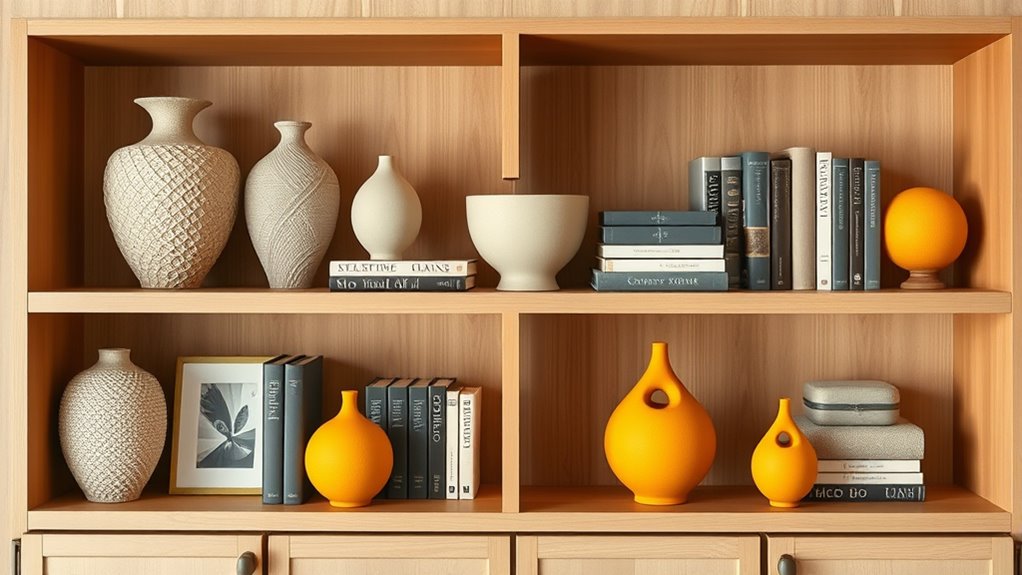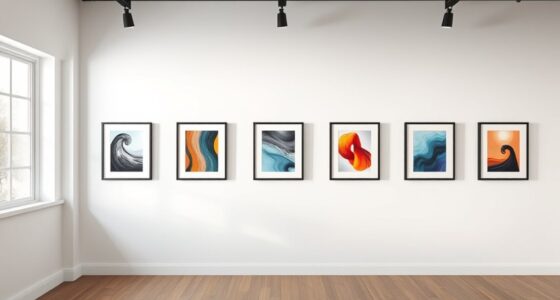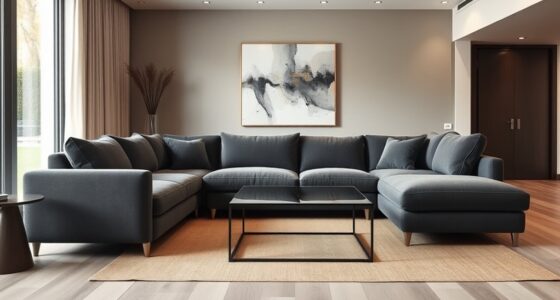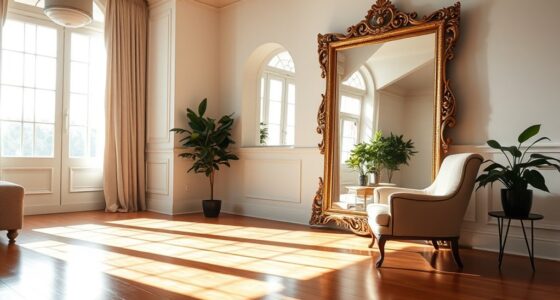To style your shelves effectively, follow the 60-30-10 rule to balance your decor. Use 60% of large, eye-catching items like books and plants as your base, creating a strong foundation. Add 30% of medium-sized accents like art or sculptures to introduce interest. Finish with 10% small decorative pieces for detail and charm. Focusing on proper proportion and arrangement makes your shelves look intentional and harmonious—keep exploring to learn more tips and tricks.
Key Takeaways
- Follow the 60-30-10 rule: 60% large, dominant items, 30% medium statement pieces, 10% small decorative accents.
- Arrange large items first to establish structure and balance as the base of your display.
- Place medium-sized accents slightly off-center or in clusters to add visual interest and movement.
- Use small decorative items sparingly, grouping them in odd numbers to fill gaps and add charm.
- Focus on balancing visual weight, mixing textures and heights for a cohesive, intentional shelf styling.

Ever wonder how to create a perfectly styled shelf that instantly elevates your space? The secret lies in understanding the Shelf Styling Formula, specifically the 60-30-10 rule. This simple yet powerful guideline helps you achieve a balanced, harmonious look without the guesswork. When you apply this rule, you’re effectively organizing your shelf into three visual zones, each with a distinct purpose and visual weight. By doing so, you ensure your display feels intentional and polished, no matter what items you choose.
Start with the 60% base. This is your foundation, so select the largest elements that will dominate the shelf. Think books, large decorative boxes, or sizable plants. These items set the tone and provide a sturdy visual anchor. When arranging them, aim for a sense of balance but avoid symmetry—mixing heights, textures, and colors keeps the look dynamic. Position these larger objects first, lining them up along the shelf to create a solid framework. This base gives your display structure and prevents it from feeling cluttered or haphazard.
Start with large, balanced pieces to create a strong, dynamic shelf foundation.
Next, dedicate around 30% to medium-sized accents. These are your statement pieces that add personality and interest. Art pieces, medium-sized vases, sculptures, or framed photos work well here. They shouldn’t overshadow the base items but should complement and elevate them. Place these elements slightly off-center or in clusters to create visual movement. Play with layering by tucking smaller items in front or behind these accents to add depth and dimension. This middle section is where you inject your personal style, so choose pieces that resonate with your aesthetic. Incorporating acrylic or hydrocolloid patches in small decorative containers can add a trendy touch to your display.
Finally, allocate about 10% for small decorative touches. These are your finishing flourishes—trinkets, candles, small plants, or decorative objects. These tiny details add charm and finesse to the overall look. Use these sparingly to avoid clutter but enough to fill in gaps and create visual interest. Grouping small items together in odd numbers, like three or five, generates a more natural, appealing arrangement. These accents are your opportunity to introduce pops of color or texture, tying the whole display together with a cohesive, styled appearance.
Frequently Asked Questions
How Can I Adapt the 60-30-10 Formula for Small Shelves?
To adapt the 60-30-10 formula for small shelves, focus on balancing your items carefully. Use one dominant piece that takes up about 60% of the space, like a bold decor item or a larger book. Then, add two smaller accessories or books to make up 30% and 10%, respectively. Keep everything uncluttered, and prioritize quality over quantity to create a balanced, visually appealing display even on limited space.
What Color Schemes Work Best With This Styling Approach?
Ever wonder which colors truly captivate when using this styling approach? You’ll want to start with neutral shades for a calming base, then add pops of bold hues to create visual interest. Incorporate accent colors that complement your main palette, and don’t shy away from unexpected combinations—they can make your shelves stand out. With this strategy, you’ll craft a balanced, eye-catching display that invites curiosity and admiration.
How Do I Incorporate Personal Items Without Cluttering?
To incorporate personal items without clutter, choose meaningful pieces that complement your color scheme and style. Limit each shelf to a few select items, arranging them with space to breathe. Use varying heights and textures to create visual interest. Keep the overall look balanced by grouping similar items and avoiding overcrowding. Regularly declutter to maintain a clean, personalized display that feels curated rather than chaotic.
Can This Formula Be Used for Non-Traditional Shelving Units?
Did you know that 78% of people feel more organized with effective display techniques? Yes, you can definitely adapt this formula for non-traditional shelving units. Focus on balancing proportions—use 60% for the main items, 30% for accents, and 10% for personal touches. Whether it’s a ladder, crates, or wall-mounted shelves, this approach helps create a cohesive, stylish display without cluttering your space.
What Are Common Mistakes to Avoid When Applying This Method?
You should avoid overcrowding the shelves, as it makes the display look cluttered and confusing. Don’t rely solely on the 60-30-10 rule without considering your space’s unique features; flexibility is key. Keep color harmony in mind, and avoid mixing too many contrasting hues. Also, steer clear of placing items randomly—think about balance and visual flow. Ultimately, forget about neglecting lighting; good illumination enhances your display’s appeal.
Conclusion
Now that you know the 60-30-10 shelf styling formula, it’s time to transform your space with confidence and creativity. With a little planning and a splash of style, you’ll easily elevate your shelves from simple storage to stunning displays. Remember, balance brings beauty, and boldness breeds brilliance. So, start styling, stay inspired, and show off your space’s true personality—because perfectly curated shelves are just a formula away!









